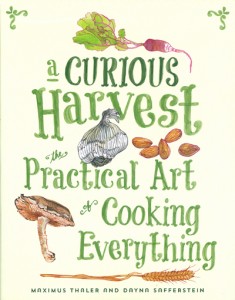
 copyright the Chronicle September 10, 2014
copyright the Chronicle September 10, 2014
by Joseph Gresser
A Curious Harvest: The Practical Art of Cooking Everything, by Maximus Thaler and Dayna Safferstein; published by Quarry Books, Beverly, Massachusetts, 2014; 160 pages, softbound, $24.99.
There is hardly any point in searching for a topic for this column. Like a cow grazing in the field, the writer is best off using what he finds before him.
In this case it is A Curious Harvest: The Practical Art of Cooking Everything. Elka Schumann handed a copy of the book to me a week or so ago while we stood talking in the kitchen at the Bread and Puppet Theater in Glover.
Ms. Schumann reminded me that Maximus Thaler, the book’s author, worked several summers as part of the crew that turns out the vast quantities of nutritious and tasty food that fuel the theater, and asked me if I might be interested in reading it.
I was curious, but had no idea of what a timely addition to the kitchen library Mr. Thaler’s volume would turn out to be. It is full of exactly the right kind of information for garden cleanup time.
That is the point in the summer when the berry bushes and vegetable plants that have been laboring to produce food for the table are beginning to get weary. A bean plant may no longer have the vigor to fill the harvest basket, and may, instead, grudgingly give up a couple of handfuls.
The world of the unpredictable pantry is where Mr. Thaler lives, although his is a more urban version of the phenomenon. He is a dumpster diver or, to use the more genteel term, a freegan.
Scrounging food that is less than saleable, but still good to eat, is a matter of principle for Mr. Thaler and he even attempted to start a restaurant where all the food would be gleaned from supermarket trash bins.
One of the problems of supplying a kitchen from the food discarded by stores is that one never knows what to expect. It’s not like shopping for the ingredients for a favorite recipe.
If a worker notices a cracked shell in a carton of a dozen eggs, an omelet might be on the menu, but there is no way to know in advance.
Regular recipes are useless in this situation, and Mr. Thaler’s book has none. Instead he discusses individual ingredients, their particular qualities, and suggests what other foods might go well with them.
For instance Mr. Thaler says zucchini should be crunchy when it is being prepared for cooking. It can be baked, grilled, roasted, boiled into soups, or fried.
He points out the similarity of zucchini to eggplant and suggests baking them together with a topping of pepper and cheese. Mr. Thaler also suggests adding it to a spaghetti sauce or frying it with tofu and cardamom seeds.
The book is divided into sections, each dealing with a category of food: vegetables, carbohydrates, fruits, protein, dairy, flavoring vegetables, flavorers, sweeteners, herbs, and spices.
Each ingredient is given at least a page to itself and each page is enlivened by the charming illustrations provided by Dayna Safferstein.
Much of the information is very general. In the protein section beef, pork, and lamb are covered together on the mammal page, while chicken, turkey, and ducks can be found under birds.
Where the book excels is in its treatment of foods that may be less familiar to most cooks. The carbohydrate section, for instance, contains very helpful information on grains such as millet and quinoa and starchy vegetables like plantains and sweet potatoes.
Mr. Thaler’s method is quickly grasped and the book is likely to be a useful tool to help cooks feel comfortable improvising with the ingredients on hand.
While dumpster diving is, generally speaking, an urban activity (people are less invisible in most of Vermont than they are in more densely populated regions), people still find themselves needing to whip up a meal based on what’s on hand.
That may be because there are things in the refrigerator that must be cooked or composted, or because circumstances require getting supplies from a local food shelf. At this time of the year, almost everyone with a garden is going to have to use some imagination to make full use of the oddly assorted fall harvest.
One of the best ways to deal with having an odd lot of veggies, especially as autumn’s chill comes on, is a soup — and one of the best soups for clearing out the garden is minestrone.
I have a friend who makes a superb version of this Italian classic, and she was kind enough to give me something like a recipe.
Minestrone
Must have in the soup:
Broth — meat (chicken or beef), veggie broth, bean cooking water, or some combination of the above
Sofrito: garlic and onions browned slowly in olive oil
Carrots
Celery
Tomatoes, preferably with skins removed
Beans, canned or cooked up from dried state
Green beans
Thyme, oregano, bay
Optional ingredients:
Leeks
Summer squash
Mild turnips
Robust greens — chard, for example
Cubed cooked meat or sliced cooked sausage
Cooked pasta (macaroni, rotini, etc. — not spaghetti types). Don’t add too much, as pasta will expand and could overwhelm the soup
Fennel bulb
Fennel seed
Inappropriate ingredients (they would turn the soup into something else):
Beets or members of the cabbage family
Things to add to the bowl when serving:
Pesto with basil and parsley or gremolata (pesto with orange peel)
Fresh grated hard Italian cheese like Romano or Parmesan.
Friendly advice:
Make the soup early in the day or the day before serving so flavors meld.
contact Joseph Gresser at [email protected]
For more free articles from the Chronicle like this one, see our Reviews pages. For all the Chronicle’s stories, subscribe:
Print subscription
Annual online subscription
Short-term online subscription







